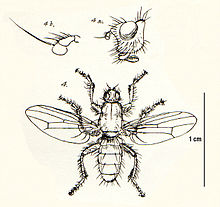- Coelopa frigida
-
Coelopa frigida 
Scientific classification Kingdom: Animalia Phylum: Arthropoda Class: Insecta Order: Diptera Family: Coelopidae Genus: Coelopa Species: C. frigida Binomial name Coelopa frigida
(Fabricius, 1805)Coelopa frigida is a species of seaweed fly or kelp fly. It is the most widely distributed species of seaweed fly.[1] It can be found on most shorelines in the temperate Northern Hemisphere.[1] Other species of seaweed flies include Coelopa pilipes.[2]
The fly has a grayish black body and yellow-brown legs.[1]
The fly oviposits in dead kelp that washes up on beaches.[3] This is the only place it lays eggs, and it can do so on many species of kelp and seaweed,[4] including species of Laminaria and Fucus.[5] A female fly lays up to five clutches of 80 eggs each.[6] The larvae feed upon the bacteria coating the dead kelp.[4] The life cycle is about 11[1] or 12[6] days long.
"Blooms" of the flies occur at times, possibly when temperatures and amounts of kelp increase.[3]
This fly is sometimes cultured in the laboratory.[6] Its behavior is studied in an effort to understand sexual selection, especially the topic of female choice.[7] Studies suggest that female flies of this species prefer larger males to smaller.[8][9] The species engages in sexual conflict.[10] Females perform rejection behaviors when mounted by males, and may mate with larger males because larger males are better able to force the mating.[10] As females are more likely to successfully reject smaller males, sexual selection favors larger ones.[10] Mating behaviors are genetically influenced, as evidenced by a preference for smaller males among females of a certain genotype.[11]
This fly is host to the mite Thinoseius fucicola.[2] It provides food for seabirds such as the Purple Sandpiper (Calidris maritima).[12] It competes with another seaweed fly, C. pilipes, for resources.[5]
References
- ^ a b c d Kelp Fly. Oceana.org
- ^ a b Gilburn, A. S., et al. (2009). Sex-biased phoretic mite load on two seaweed flies: Coelopa frigida and Coelopa pilipes. Environ Entomol 38:6 1608.
- ^ a b Mather, K. South Bay beaches hit by swarms of kelp flies. Los Angeles Times June 18, 2011. Accessed June 18, 2011.
- ^ a b Cullen, S. J., et al. (1987). (Dietary requirements of seaweed flies (Coelopa frigida). Estuarine, Coastal and Shelf Science 24:5 701.
- ^ a b Edward, D. A., et al. (2008). Investigating dietary preferences in two competing dipterans, Coelopa frigida and Coelopa pillipes, using stable isotope ratios of carbon and nitrogen. Entomologia Experimentalis et Applicata, 127 (3) 169-175.
- ^ a b c Burnet, B. and U. Thompson. (1960). Laboratory culture of Coelopa frigida (Fabricius) (Diptera: Coelopidae). Proceedings of the Royal Entomological Society of London. Series A, General Entomology. 35:4-6 85-89.
- ^ MacDonald, C. and J. F. Y. Brookfield. (2009). Intraspecific molecular variation in the seaweed fly Coelopa frigida consistent with behavioural distinctness of British and Swedish populations. Molecular Ecology 11:9 1637.
- ^ Gilburn, A. S., et al. (1992). Female mating preference for large size in Coelopa frigida (seaweed fly). Heredity 69 209.
- ^ Gilburn, A. S. and T. H. Day. (1994). Sexual Dimorphism, Sexual Selection and the $\alpha \beta $ Chromosomal Inversion Polymorphism in the Seaweed Fly, Coelopa frigida. Proc. R. Soc. Lond. B 257: 1350 303-309.
- ^ a b c Shuker, D. M. and T. H. Day. Mate sampling and the sexual conflict over mating in seaweed flies. Behavioral Ecology 13:1 83.
- ^ Blyth, J. E. and A. S. Gilburn. (2011). The function of female behaviours adopted during premating struggles in the seaweed fly, Coelopa frigida. Animal Behaviour 81:1 77.
- ^ Summers, R. W., et al. (1990). Tidal and sexual differences in the diet of Purple Sandpipers Calidris maritima in Scotland. Bird Study 37:3 187.
Further reading
- Edward, D. A. (2008). Habitat Composition, Sexual Conflict, and Life History Evolution in Coelopa frigida. PhD Thesis, University of Stirling.
Categories:- Flies
- Animals described in 1805
Wikimedia Foundation. 2010.
